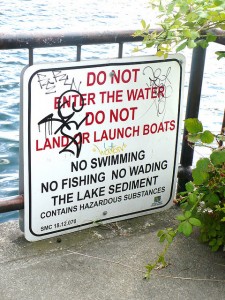Posts Tagged ‘Lead Pollution’
Morning News on Frisco: City Must Come Clean
 This editorial ran in Today's Dallas Morning News:
This editorial ran in Today's Dallas Morning News:
"Environmentalists and Frisco residents have long wondered whether contamination existed beyond the borders of Exide Technologies’ shuttered Frisco plant.
Now they know, thanks to recent open records requests from Frisco Unleaded and Downwinders at Risk to state environmental officials. Waste materials from battery recycling processes exist in the 340-acre Grand Park area, the proposed site of an elaborate regional park.
If you live in Frisco, you should be perturbed that you didn’t hear this sobering news sooner — or hear it from the city, which has known of these findings for a couple of months. Instead, the information comes from environmental groups that stumbled across the test results in the Texas Commission on Environmental Quality’s response to their records request.
Given the lingering controversy over the extent and pace of the cleanup of Exide’s plant site, city officials owed it to residents to disclose everything they knew as soon as they learned it. Governmental transparency and communication are important, especially when health, safety, property values and the credibility of cleanup efforts are at stake. This is important because the new reports detail problems on land outside of Exide’s property that need to be cleaned up.
City officials contend they’ve been open with residents and last Monday filed an application to include the Grand Park area in a state voluntary cleanup program.
The city has done itself no favors by sitting on information. Frustrated with the pace of the cleanup, environmental groups want the Environmental Protection Agency to issue an imminent and substantial endangerment order and take over cleanup from TCEQ, which they allege is moving too slowly. While that is unlikely, the complaint underscores the desire of residents and environmental groups to make sure the cleanup is done properly.
What Frisco residents want is what any resident of any community wants — assurances that land that could house levels of lead, cadmium and arsenic in excess of state benchmarks will be cleaned up. The best way to do that is for Frisco to make sure residents know what’s going on — even steps the city might think are minor and procedural. And if subsequent testing definitively links the broader contamination to Exide, then Frisco has to make sure the battery company, now in bankruptcy proceedings, will pay for the cleanup.
More than a year has passed since Exide and Frisco struck a landmark deal to shutter the battery recycler, a major step toward Frisco reclaiming industrial land for a cleaner environment and recreational purposes. Now Frisco must make sure that the area is free of potentially deadly contaminants and that residents are fully aware of the extent of contamination.
Frisco has an opportunity to use land for a grand community vision, but it has to deal openly and transparently with residents and make sure those responsible for the contamination clean up the mess they’ve made."
Residents Push Back on Frisco Smelter Clean-Up Standards; Report Raises Questions About Huge New City Park Next to “Potential Superfund Site”
 (Frisco)–Frisco residents directly challenged their city’s attempt to gloss over what they say is an important decision to use a less-protective testing method to find toxic contamination on the Exide smelter site, while also releasing a new report that chronicles how that contamination could disrupt plans to build the city’s ambitious “Grand Park.”
(Frisco)–Frisco residents directly challenged their city’s attempt to gloss over what they say is an important decision to use a less-protective testing method to find toxic contamination on the Exide smelter site, while also releasing a new report that chronicles how that contamination could disrupt plans to build the city’s ambitious “Grand Park.”
Saying city officials either don’t know what method is actually being used for finding “hot spots” of contamination, or isn’t being truthful about its use, members of Frisco Unleaded contrasted an official city denial from Assistant City Manager Ron Patterson with a March memo from the Texas Commission on Environmental Quality.
“Although you state in your response….“an industrial sampling protocol is not being used on the J Parcel,” you are incorrect,” says a letter sent by the group to Patterson and the Frisco City Council on Monday. “Please refer to the Texas Commission on Environmental Quality memo, dated March 8th of this year, accompanying our May 28th letter….TCEQ’s Danielle Lesikar clearly states that the 2 samples per acre testing method, “is a Commercial Industrial Standard,” and “only meets (the) Commercial-Industrial” standards. We’d appreciate if you’d forward documentation that disproves this statement….”
Members of the group say the difference is small but critical. Instead of eight soil samples per acre at the highly contaminated site, Exide is only sampling twice per acre, and so far less likely to find all the toxic material that needs to be removed to bring down high levels of lead, cadmium and other potential contaminants after almost 50 years of smelter operation.
Making sure there are no toxic surprises is important for redevelopment of the site itself, as well as the construction and use of the City’s new 275-acre Grand Park, located only 500 feet away from the smelter property and directly downstream of the Exide contamination via Stewart Creek, which is key to the park’s chain of lakes and water features. That’s the subject of the group’s new report.
“Poisoned Park? How Exide’s Lead Contamination Risks Frisco’s Grand Park,” was released to coincide with the last of three public “design meetings” for Grand Park at City Hall on Monday afternoon. In it, Frisco Unleaded compiles the long litany of abuse to Stewart Creek and the surrounding land by the smelter recorded by state and federal inspectors, including lining the banks of the Creek with toxic lead slag waste, dumping lead waste directly into the Creek, and locating waste dumps and pits in its floodplains.
“This poor Creek has been more or less an open sewer for the entire Exide smelter property for decades. There’s every indication that a lot of contamination is still there. And yet city officials are pretending that they aren’t trying to build a huge park centered along the course of this same Creek, immediately next door, and upstream of the Smelter. None of the previous design meetings have even raised the possibility of an environmental assessment of the threat Exide’s contamination poses to the Park,” said Frisco Unleaded board member Meghan Green.
Besides chronicling the past and current threats to the creek and potential ones to the new Park, the report features the boundaries of Exide’s hazardous waster permit superimposed on FEMA 100-year floodplain maps and USGS topographical maps to indicate how much of Stewart Creek has been affected by the Smelter, which literally sits on either side of its banks before flowing west under the Dallas North Tollway into what would be the new Grand Park.
“It’s important to get the most protective clean-up of the Exide property that we can” said Frisco Unleaded Chair Colette McCadden, “because all of the run-off from the property will be headed directly into the Park and the City itself has proposed building an entire Stewart Creek green belt corridor that would follow the Creek into the Park. This isn’t an industrial site that is sitting in isolation from people and activity. This is a site that’s next to Frisco’s largest park.”
“With the financial condition of the company deteriorating,” added Downwinders at Risk Director Jim Schermbeck, “it’s very possible the smelter site could end up on the EPA’s federal Superfund Site list, and then you’d have the a toxic waste dump site as a neighbor to Frisco’s most ambitious park.”
Among problems for Grand Park development pointed out by the report:
- Despite inspection reports citing known and potential contamination affecting Stewart Creek, no remediation has been performed there in 13 years.
- There’s not sufficient protection from flooding at the site, despite most of the facility being located in low-lying, flood prone areas.
- The FEMA 100-year floodplain runs directly through a landfill full of Exide lead slag, within just 100 feet of a “waste pile” of contaminated dredging from Stewart Creek, and within 200 feet of lead landfills that are in various states of disrepair.
- There’s been no extensive testing of soil, sediment or water within the boundaries of the new park, or between the Smelter and the park, where new contamination has recently been discovered.
The report makes four specific recommendations to insure park and public safety:
- City Officials should commission a full environmental assessment of the Grand Park Project before project planning and development go any further.
- The clean-up of the Exide smelter site should be to the most protective “Residential” standards to allow for open spaces use along Stewart Creek.
- All landfills, dumps and pits of lead waste should be removed from the Exide site to prevent future contamination problems from occurring.
- The water quality of Stewart Creek must be assured.
